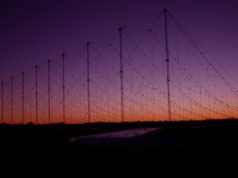The Russian Kinzhal hypersonic missile destroys Patriot Air Defence System

The Kinzhal is a Russian airborne missile system with a hypersonic aero-ballistic missile
A Russian Kinzhal hypersonic missile hit a US-made Patriot air defence system in Kiev during a special military operation in Ukraine, Defence Ministry Spokesman Lieutenant-General Igor Konashenkov reported last Tuesday.
The Kinzhal is a Russian airborne missile system with a hypersonic aero-ballistic missile.
President Vladimir Putin first mentioned this weapon during his address to both houses of Russia’s parliament on March 1, 2018. He had then announced that Russia possessed “an airborne high-precision hypersonic missile system” “unrivalled in the world.”
Russia had successfully completed the tests of the hypersonic missile system and deployed it on experimental combat duties at airfields of the Southern Military District from December 1, 2017. A video of the takeoff of a MiG-31 fighter jet with a Kinzhal hypersonic missile on an external central hardpoint and computer graphics revealing the destruction of ground and naval targets were released soon after.
This news came as a surprise for foreign military specialists because prior to that neither official nor unofficial sources had made any mention of the existence of an airborne hypersonic weapon in Russia.
The Russian Defence Ministry reported on March 10, 2018 that Russia had carried out a training launch of a Kinzhal airborne high-precision hypersonic missile “in the designated area.”
On May 9, 2018, two Russian MiG-31K fighters carrying Kinzhal hypersonic missiles took part in the air parade over Moscow’s Red Square during the Victory Day celebrations.
It was reported on July 2, 2018, citing a source in the Russian Defence Ministry that the Kinzhal hypersonic missile would be tested on a Tu-22M3 long-range bomber that would be capable of carrying several such missiles and its striking range would increase to 3,000 km.
On July 19, 2018, details of the experimental operation of the Kinzhal hypersonic missiles system were disclosed. The Russian Aerospace Forces Deputy Commander-in-Chief Sergey Dronov reported, the MiG-31K fighters, the carriers of Kinzhal hypersonic missiles, had conducted over 350 flights since the Kinzhals assumed combat posture, of which 70 flights were carried out with mid-air refueling. The Kinzhal hypersonic missile system had been on routine patrols over the Caspian Sea since April 2018, the ministry said.
Russia then set up a separate air regiment of MiG-31K fighters armed with Kinzhal hypersonic missiles. On February 19, 2022, the Russian Aerospace Forces successfully test-launched Kinzhal hypersonic missiles during the drills of Russia’s strategic deterrence forces.
On April 19, 2022, Defense Minister Shoigu reported that the target acquisition time for Kalibr and Kinzhal missiles had been cut by tens of times due to new signal systems.
Kinzhal missile flies at ten times the speed of sound, hits targets at a range of over 2,000 km, manoeuvres along its entire flight path, breaching all air defence and anti-ballistic missile defence systems, and can carry both conventional and nuclear warheads.
The defence official pointed out, the MiG-31 fighter was chosen as the Kinzhal carrier because “it is most of all fit for accelerating the missile to the required speeds at required altitudes.” The hypersonic missile’s multi-purpose warhead can hit both stationary and moving targets, including enemy warships.
Another source confirmed that during a test-launch, “the missile accelerated to Mach 10.” The Russian Aerospace Forces officially did not comment on the information provided by the sources.
Both Russian and foreign experts say that the Kinzhal is a 9M723 single-stage solid-propellant missile of the Iskander-M ground-based tactical missile system upgraded for air launch. Experts also point out that the Kinzhal hypersonic missile demonstrated in the video clips looks similar to the Iskander tactical missile. In their opinion, the use of the existing ground-based missile helped cut the time of designing a new weapon.
Experts presume, the Kinzhal’s 2,000 km strike range is ensured both by the combat radius of the MiG-31 fighter and the missile’s flight range. The hypersonic velocity in the final flight path is reached both through the carrier aircraft’s acceleration to the supersonic speed (i.e. a MiG-31 fighter performs the role of the first stage) and the missile’s own thrusters and flight path.
The airborne missile system can be employed to strike vital infrastructure facilities, such as command centers, air defense and anti-ballistic missile defense systems, airbases, aircraft carriers and other targets.
Russia first employed the Kinzhal hypersonic missile system in the special military operation in Ukraine on March 18, 2022, wiping out a Ukrainian underground missile and aircraft ammunition depot near the urban-type settlement of Delyatin in the Ivano-Frankovsk Region. As the Russian Defense Ministry reported, the Kinzhal missile was launched from a distance of over 1,000 km. The hypersonic missile covered its distance within less than 10 minutes. The warhead destroyed a sheltered underground arms arsenal in mountainous terrain through the missile’s hypersonic speed and super-high kinetic energy.
The following day, a Kinzhal missile hit a large Ukrainian fuel and lubricants base near the settlement of Konstantinovka in the Nikolayev Region. In this case, the hypersonic weapon was employed due to its stealth and invulnerability to any air defense and anti-ballistic missile defence systems. It was also reported that the Kinzhal hypersonic weapon was launched with a conventional warhead.
As per Defence Minister Shoigu, the Kinzhal hypersonic missile had been employed three times in the special military operation in Ukraine. Chief of the Russian General Staff, First Deputy Defence Minister Valery Gerasimov specified at a briefing for foreign military attaches on December 22 that year, the Kinzhal hypersonic weapon proved to be highly efficient and “invulnerable to air defence systems deployed in Ukraine.”



